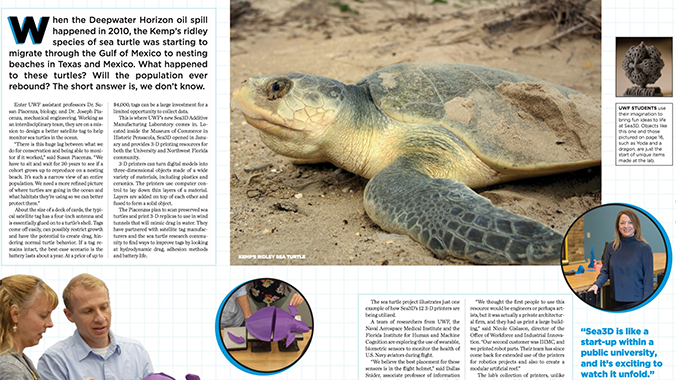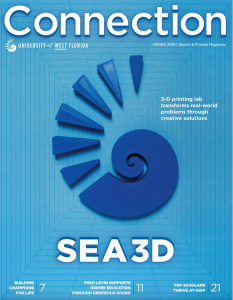Spring 2018 Alumni Magazine Cover Story: Sea3D

This cover story was written for the Spring 2018 issue of the University of West Florida’s alumni magazine.
Read the story in UWF Connection (PDF)
View the full Spring 2018 issue.
Sea3D: From sea turtles to helmets for the U.S. Navy, UWF’s new 3-D printing lab brings additive manufacturing to downtown Pensacola.
When the Deepwater Horizon oil spill happened in 2010, the Kemp’s ridley species of sea turtle was starting to migrate through the Gulf of Mexico to nesting beaches in Texas and Mexico. What happened to these turtles? Will the population ever rebound? The short answer is, we don’t know.
Enter UWF assistant professors Dr. Susan Piacenza, biology, and Dr. Joseph Piacenza, mechanical engineering. Working as an interdisciplinary team, they are on a mission to design a better satellite tag to help monitor sea turtles in the ocean.
“There is this huge lag between what we do for conservation and being able to monitor if it worked,” said Susan Piacenza. “We have to sit and wait for 30 years to see if a cohort grows up to reproduce on a nesting beach. It’s such a narrow view of an entire population. We need a more refined picture of where turtles are going in the ocean and what habitats they’re using so we can better protect them.”
About the size of a deck of cards, the typical satellite tag has a four-inch antenna and is essentially glued on to a turtle’s shell. Tags come off easily, can possibly restrict growth and have the potential to create drag, hindering normal turtle behavior. If a tag remains intact, the best-case scenario is the battery lasts about a year. And at a price of up to $4,000, tags can be a large investment for a limited opportunity to collect data.
This is where UWF’s new Sea3D Additive Manufacturing Laboratory comes in. Located inside the Museum of Commerce in Historic Pensacola, the Sea3D lab opened in January and provides 3-D printing resources for both the University and the Northwest Florida community.
3-D printers can turn digital models into three-dimensional objects made of a wide variety of materials, including plastics and ceramics. The printers use computer control to lay down thin layers of a material. Layers are added on top of each other and fused to form a solid object.
The Piacenzas plan to scan preserved sea turtles and print 3-D replicas to use in wind tunnels that will mimic drag in water. They’re partnering with satellite tag manufacturers and the sea turtle research community to find ways to improve tags by looking at hydrodynamic drag, adhesion methods and battery life.
The sea turtle project is just one example of how the Sea3D’s 12 3-D printers are being utilized.
A team of researchers from UWF, the Naval Aerospace Medical Institute and the Florida Institute for Human and Machine Cognition (IHMC) are exploring the use of wearable, biometric sensors to monitor the health of U.S. Navy aviators during flight.
“We believe the best placement for these sensors is in the flight helmet,” said Dallas Snider, associate professor of information technology and computer science. “The Sea3D Lab allows us to scan and print replicas of the helmets and devices and experiment with sensor placement and integration.”
Sea3D’s very first customer was somewhat unexpected.
“We thought the first people to use this resource would be engineers or perhaps artists, but it was actually a private architectural firm, and they had us print a large building,” said Nicole Gislason, director of the Office of Career and Professional Education. “Our second customer was the IHMC, and they had us print robot parts, and their team has since come back for extended use of the printers for robotics projects and also to create a modular artificial reef.”
The lab’s collection of printers – unlike anything that’s available to the public in the Southeast U.S. – includes a carbon fiber printer; six large-format MakerBot printers; a Mojo printer that prints two types of plastic; and four resin printers that print medical grade items.
Sea3D accommodates UWF students and faculty from academic disciplines including engineering, art, industrial and organizational psychology, business and healthcare. It also provides a space for business leaders and community members to collaborate with students, as well as put real-world science on display for the thousands of local K-12 students who visit the Museum of Commerce each year.
“Sea3D is a hub for multidisciplinary research, invention and discovery in the high-demand field of additive manufacturing,” Gislason said. “It’s like a start-up within a public university, and it’s exciting to watch it unfold.”
Funded by an appropriation of $351,000 from the Florida Legislature and championed by Rep. Frank White, the lab’s opening marks the official launch of the UWF Innovation Network, which connects physical campus destinations along the Gulf Coast of Northwest Florida for innovation, collaboration, research and engaged learning to prepare students for the changing world and workforce of tomorrow.
Through a collaboration with FloridaMakes, a statewide, industry-led partnership that works to strengthen Florida’s high-wage manufacturing sector, Sea3D is well-positioned to foster connections within the state’s manufacturing industry.
“UWF will launch students into occupations and careers in areas that promote economic recovery, diversification and enhancement,” said UWF President Martha D. Saunders. “We’re building multidisciplinary innovative knowledge clusters focused on high-demand programs of emphasis.”
The knowledge clusters that make up UWF’s Innovation Network will include living and learning environments, disciplinary labs, K-12 outreach, research labs, internships, industry partners, projects with impact and leading experts.
“Education is the answer to almost every important question facing our region,” Saunders said. “We are creating a pipeline of talent development, and students in these programs will enter – and perhaps create – high-wage jobs that greatly impact the economy.”
Christopher Borthwick, a senior studio art major from Fort Walton Beach, is a Sea3D lab technician. He was originally interested in working at the lab because of his background in sculpture. Borthwick’s senior exit show featured a piece he created taking 3-D printed artifacts and welding them together.
“My goal was to go into digital art and new media practices, using 3-D scanning technology to scan my sculptures and scale them down,” he said. “But I found I’ve acquired this new skillset – every day is like a crash course into this new equipment.”
On any given day in the lab, Borthwick is working alongside his fellow lab techs, professors and researchers from the University and the larger business community.
Much of the work revolves around problem solving with clients to help them ensure their jobs print correctly. Borthwick trains on new equipment, helps with the post-processing of projects and maintains the printers (even spending four hours one day taking a printer apart to install a new sensor). Sea3D has also allowed him to pursue certification in SolidWorks, a 3-D CAD (computer-aided design) engineering software.
“I’ve been doing a little research, and these skills are in demand, and the jobs are popping up all over the place,” he said. “It’s been a very entrepreneurial experience working here – we teach ourselves to problem solve, we tackle issues as a team and we fill in the gaps. New media artists are collaborating with engineers, biologists, scientists and architects. It’s what we will encounter in the workplace – different people and skillsets, approaching things with an openness to learn.”
Photo credit: University of West Florida

